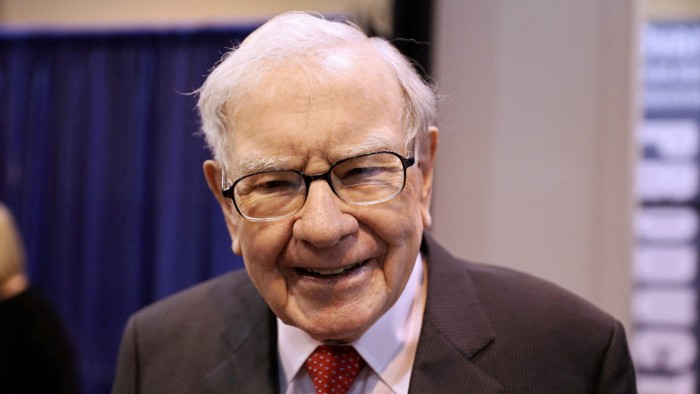Buffett-inspired ETP puts innovation in the hot seat

Simply sign up to the Exchange traded funds myFT Digest -- delivered directly to your inbox.
Latest news on ETFs
Visit our ETF Hub to find out more and to explore our in-depth data and comparison tools
The pace of innovation in the exchange traded fund industry shows no sign of slowing with one of the latest inventions aimed squarely at admirers of famed investor Warren Buffett.
However, with one analyst commenting that it appears to be filled with “liquid horse manure”, the exchange traded product comes with a health warning.
The Buffettique Growth ETP (BUFF), which has launched on the London Stock Exchange available in sterling, euros and US dollars, aims to invest in stocks and funds that “relate to Warren Buffett’s investment career”.
But the adage that Buffett built his reputation investing in businesses not stocks appears to have been lost on Arcanum Asset Management, a wealth manager that has brought the ETP to market with the white-label service help of Leverage Shares.
Instead, the ETP has a 20 per cent weighting to Leverage Shares 2X Long Berkshire Hathaway ETP — leveraged products normally come with the recommendation that they are held only intraday — which provides double the positive or negative returns of Berkshire Hathaway, Buffett’s primary investment vehicle.
The rest of the ETF’s 80 per cent “core portfolio” is distributed between large investment trusts such as Scottish Mortgage Investment Trust and BlackRock Smaller Companies Trust. That leaves 20 per cent dedicated to stocks and ETPs defined as “workouts”. At present the actively managed ETP is invested in chipmakers Nvidia and Advanced Micro Devices, Netflix and Google’s parent, Alphabet.
“I am not sure how the 2X daily levered Berkshire Hathaway ETP will play out given how these things tend to lose money in the long term,” said Peter Sleep, senior portfolio manager at Seven Investment Management. “Probably not well, although there is so much going on here that you might not notice for a quite a while,” he added, referring to the potentially unique decision to include stocks, investment trusts and ETPs inside one ETP wrapper.
“I have always said that an ETF is like a glass bottle. You can put water into it or nitroglycerine. In this case they have put in liquid horse manure,” Sleep quipped.
Kenneth Lamont, senior fund analyst for passive strategies at Morningstar, also questioned the wisdom of investing in the fund.
“The obvious question when anyone launches a product that invests like Warren Buffett is why not just buy Berkshire Hathaway and actually invest like Warren Buffett?” Lamont said.
He also drew attention to the ETP’s very unusual fee structure. Unlike most ETPs it not only charges an annual management fee, which in this case is set at a relatively high level for the ETF industry of 1 per cent, it also charges a high-water mark performance fee of 10 per cent — a fee structure usually associated with hedge funds and calculated daily that means investors will also pay 10 per cent of returns above the previous highest level achieved by the ETP.
“The fees alone are a real red flag,” said Lamont, commenting that Buffett is known for consistently guiding investors towards low-fee investments.
Lamont also took issue with the ETP’s stated active management intentions. “Warren Buffett recommends against trying to time the market, yet this strategy attempts to determine whether markets are ‘risk-on’ or ‘risk-off’ based on short-term technical indicators and invest in complex leveraged products accordingly,” Lamont said.
BUFF’s key information document, supplied to investors. warns them: “You are about to purchase a product that is not simple and may be difficult to understand.”
Matt Rickard, managing director of Arcanum and former head of dealing at Hargreaves Lansdown, insisted that despite its complexity the ETP is based on a successful strategy that Arcanum already offers its customers.
“I wouldn’t say it is experimental. This is exactly what we offer our professional clients,” he said, adding that its structure had been carefully appraised not only for potential returns but also for liquidity.
Leverage Shares charges as little as $20,000 to bring a white-label ETP to market and says firms can expect to break even when the product has gathered $5mn in assets under management, far below the oft-quoted figure of $75mn, it says.
By what it calls “significantly lowering the barriers to entry” Leverage Shares and other white-label ETP providers could be opening the door to even more innovation. But ingenuity does not mean it is suitable for all investors. Berkshire Hathaway’s portfolio, for example, includes only two ETFs and both offer exposure to the S&P 500.
“I would wager than Mr Buffett wouldn’t touch a fund like this with the proverbial barge pole, and neither should anyone else,” said Lamont.
Comments